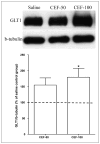Ceftriaxone, a beta-lactam antibiotic, attenuates relapse-like ethanol-drinking behavior in alcohol-preferring rats
- PMID: 23518814
- PMCID: PMC3657312
- DOI: 10.1177/0269881113482529
Ceftriaxone, a beta-lactam antibiotic, attenuates relapse-like ethanol-drinking behavior in alcohol-preferring rats
Abstract
Relapse-like ethanol-drinking behavior depends on increased glutamate transmission in the mesocorticolimbic motive circuit. Extracellular glutamate is regulated by a number of glutamate transporters. Of these transporters, glutamate transporter 1 (GLT1) is responsible for the majority of extracellular glutamate uptake. We have recently reported that ceftriaxone (CEF) treatment (i.p.), a β-lactam antibiotic known to elevate GTL1 expression, reduced ethanol intake in male alcohol-preferring (P) rats. We investigated here whether CEF treatment attenuates relapse-like ethanol-drinking behavior. P rats were exposed to free choice of 15% and 30% ethanol for 5 weeks and treated with CEF (50 and 100 mg/kg, i.p.) during the last 5 days of the 2-week deprivation period. Rats treated with CEF during the deprivation period showed a reduction in ethanol intake compared with saline-treated rats upon re-exposure to ethanol; this effect persisted for 9 days. Moreover, CEF-mediated attenuation in relapse to ethanol-drinking behavior was associated with upregulation of GLT1 level in prefrontal cortex and nucleus accumbens core. GLT1 upregulation was revealed only at the higher dose of CEF. In addition, CEF has no effect on relapse-like sucrose-drinking behavior. These findings suggest that ceftriaxone might be used as a potential therapeutic treatment for the attenuation of relapse-like ethanol-drinking behavior.
Keywords: EAAT2; Relapse; alcohol dependence; ethanol intake; glutamate.
Conflict of interest statement
The authors declare that there are no conflict of interest.
Figures




References
-
- Backstrom P, Bachteler D, Koch S, et al. mGluR5 antagonist MPEP reduces ethanol-seeking and relapse behavior. Neuropsychopharmacology. 2004;29:921–928. - PubMed
-
- Bell RL, Rodd ZA, Lumeng L, et al. The alcohol-preferring P rat and animal models of excessive alcohol drinking. Addict Biol. 2006;11:270–288. - PubMed
-
- Capriles N, Rodaros D, Sorge RE, et al. A role for the prefrontal cortex in stress- and cocaine-induced reinstatement of cocaine seeking in rats. Psychopharmacology (Berl) 2003;168:66–74. - PubMed
Publication types
MeSH terms
Substances
Grants and funding
LinkOut - more resources
Full Text Sources
Other Literature Sources
Medical

